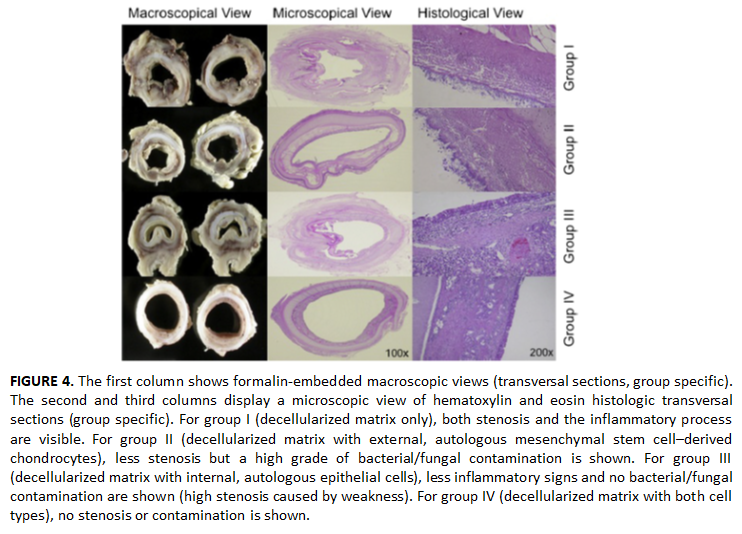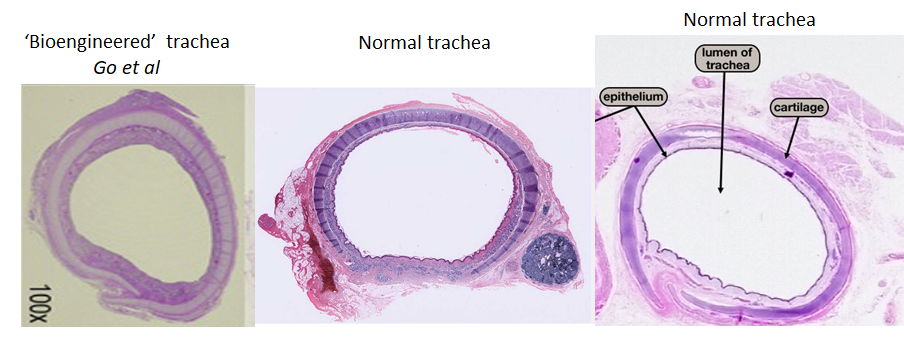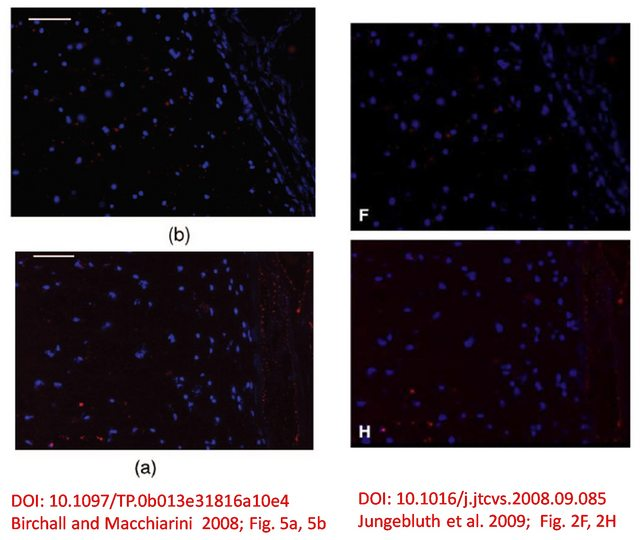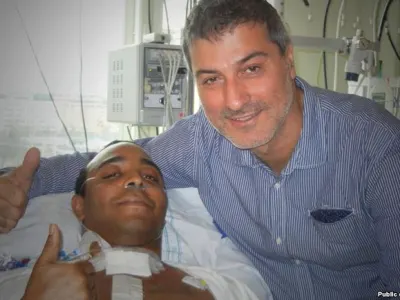Patricia Murray, professor of regenerative medicine in Liverpool and whistleblower, has been educated by an authoritative society journal that a) Paolo Macchiarini‘s trachea transplant technology does work, b) his papers were retracted unjustly, and c) she must listen to the authority of white male surgeons.
Well, not in those words, but this is what the Managing Editor of Journal of Thoracic and Cardiovascular Surgery (JTCS), Spencer McGrath, basically conveyed to Murray on behalf of the journal editors and the publishing society, The American Association of Thoracic Surgery (AATS).
The irony is that Murray just achieved a retraction of two clinical papers by Macchiarini in The Lancet, Macchiarini et al 2018 and Gonfiotti et al 2014, despite the massive resistance from medical editors and from the involved university hospitals in Spain and UK. Read here:
Swedish investigation spoils Macchiarini cover-up at Lancet
NPOF, again and again: “Philipp Jungebluth and Paolo Macchiarini guilty of research misconduct” Lancet: “Paolo Macchiarini is not guilty of scientific misconduct”
Now, these same two Lancet papers were allegedly based on a preclinical study with pigs in Barcelona, allegedly done before the first human trachea transplant of 2008 described in The Lancet (Macchiarini et al 2008). It is however much more likely that this pig study in JTCVS was in reality performed AFTER that failed human experiment, or rather never performed as described or even at all, i.e., faked:
Tetsuhiko Go , Philipp Jungebluth , Silvia Baiguero , Adelaide Asnaghi , Jaume Martorell , Helmut Ostertag , Sara Mantero , Martin Birchall, Augustinus Bader, Paolo Macchiarini Both epithelial cells and mesenchymal stem cell-derived chondrocytes contribute to the survival of tissue-engineered airway transplants in pigs Journal of Thoracic and Cardiovascular Surgery (2010) doi: 10.1016/j.jtcvs.2009.10.002
The study says:
“We recently performed the world’s first stem cell–based, fully tissue-engineered tracheal graft, which has been a success to date.8 However, before we used the graft in human subjects, we evaluated the relative contribution of the autologous biopsy-derived epithelial cells and mesenchymal stem cell (MSC)–derived chondrocytes for the survival of seeded decellularized scaffolds when implanting them orthotopically in pigs. Results are presented here.”
Macchiarini and his acolyte Philipp Jungebluth have been found guilty of research fraud several times, they have by now 11 retractions. The former was also sentenced to jail term for aggravated assault which resulted in deaths of patients. Other co-authors, senior and junior, are not to be trusted either.
Macchiarini’s former best friend in England, the UCL professor Martin Birchall, continued with both human and pig experiments, breaching many rules of medical and research ethics while hoping for money windfall from his airway transplants. Read here:
Martin Birchall’s two dead pigs to prove trachea transplants are safe
Imagine you are Martin Birchall, laryngologist and ENT surgeon, star of regenerative medicine at UCL and trachea transplant enthusiast. You and your business partner Videregen need to explain to EU bureaucrats why your technology of decellurised cadaveric trachea is perfectly safe, what with all the dead patients of yours and your former best friend Paolo…
When Birchall’s employer UCL investigated the trachea transplant scandal in 2017, they decreed that only Machiarini and other foreigners of non-English pedigree were guilty of misconduct, but otherwise this Made in England airway replacement method worked. Their only evidence was the Go et al 2010 paper in JTCVS:
“A clinical decision was made by Professor Macchiarini to treat this woman by using a decellularised human trachea and to seed this with both autologous epithelial cells and mesenchymal stromal cells (MSC). He and Professor Birchall had, at that point, a long-standing research collaboration around animal models of airway transplantation. The animal data which underpinned the use of recellularised tracheas was subsequently published in 2010 and demonstrated that decellularised trachea with chondrocytes and epithelial cells was superior to either alone or neither (Go et al 2010).”
UCL trachea transplant inquiry: scapegoating, obfuscation and a lost nose
In 2017, UCL invited an external expert commission to investigate the deadly trachea transplants performed by the former UCL honorary professor Paolo Macchiarini. An already sacked UCL nanotechnology professor, Alexander Seifalian, whose lab made the two UCL plastic POSS-PCU tracheas in 2011, was announced as the main culprit on UCL side. All this despite Seifalian’s…
The penultimate author of the JTCVS study, the German professor at University of Leipzig Augustinus Bader, has a history of stem cell quackery (read below). Because German academic community failed to intervene, he now swims in money, selling anti-aging cures in his private clinic and anti-aging skin care products online and via the high-street cosmetics shops. The media considers him to be Germany’s greatest stem cell genius, even New York Times is mightily impressed, authoritatively informing us that Bader’s “scientific background infuse his beauty products with credibility“, billionaires and Hollywood stars invest, the company’s sale numbers are breath-taking.
Macchiarini’s German (ex-)friends: Jungebluth and Bader
The trachea-transplant “super- surgeon” Paolo Macchiarini seems to be sitting out the Swedish investigations of his misconduct and patients’ deaths in Russia. He is apparently still employed at the International Research, Clinical and Education Center of Regenerative Medicine in Krasnodar, a city in south-western Russia, just across the recently occupied Ukrainian Crimea peninsula. While Macchiarini’s…
Which also means, Bader now can afford the most expensive lawyers in case anyone thinks of retracting his papers, like those with Macchiarini. In 2016, Bader informed me that he contacted Macchiarini’s team only after the 2008 Lancet publication, to offer his own ideas:
“These concepts then found their way into published animal experimental work”
Which is another clue that the animal study was performed after the 2008 trachea transplant. Here is another clue, as described on PubPeer:
“The Lancet paper indicates that Hollander and Dickson from Bristol, UK “developed the methods for growing human chondrogenic mesenchymal stem cells, advised on cell culture…”
Hollander and Dickson were not involved in this pig study by Go et al, but interestingly, the method for MSC culture and cartilage differentiation used in the Go et al and Lancet studies are exactly the same.”
This Anthony Hollander, co-author of Macchiarini et al 2008 paper in Lancet, just happens to be Murray’s boss, he is Pro-Vice-Chancellor for Research at her University of Liverpool. Back in 2008, both Hollander and Birchall were employed by the University of Bristol, where they prepared the “bioengineered” tracheal graft for human transplantation (in a pig lab!), and had Jungebluth send it to Barcelona. Read here:
Claudia’s trachea
This is the English original of my story for Hipertextual, first published in Spanish on 27.10.2016. What did we learn from the trachea transplant scandal around the miracle surgeon and stem cell pioneer Paolo Macchiarini, who used to conduct his human experiments in Germany, Spain, Italy, Sweden and Russia? That despite the stem cell fairy magic, all his…
Indeed, if the pig experiments described in the 2010 JTCVS paper were done before the 2008 transplant in a human patient, how come the patented technology by Hollander’s company was not acknowledged? The PubPeer criticism continues:
“So if we are to believe the authors of the Go et al study and accept that this study predated the human experiment (Lancet 2008), then why did they need Hollander and Dickson for the Lancet study because it looks as though the Go et al authors had already implemented the chondrogenesis technique themselves? Why did the cells for the human study need to go to Bristol if the techniques were already established in Barcelona?
So either this Go et al paper is making the false claim that the pig study predated the human experiment, OR, the Lancet 2008 publication is making the false claim that Hollander and Dickson developed the chondrogenesis technique (the Go paper implying it had already been implemented in Barcelona).”
You can read about Hollander’s key role in the 2008 human experiment below, his patented technology was decisive for the alleged success which then proved an utter failure, the patient Claudia Castillo only survived because other doctors eventually removed the rotting graft.
Macchiarini partner Anthony Hollander chairs mass-sacking committee in Liverpool
“I felt I had a lot to give the world. Getting my first at university and doing so well in research was an antidote. Underneath, though, there is part of me that feels maybe one day someone will discover that I am stupid.” – Tony “Blue Peter” Hollander
Now, either the authors of Go et al 2010 stole Hollander’s method, or they lied and the pig experiment was done after the 2008 trachea transplant. Either is a reason enough for a retraction. Not for JTCVS though!
Since 2019, Murray tried in vain to convince them to retract that dangerous paper, she eventually contacted the Committee for Publication Ethics (COPE), who in turn asked JTCVS to reply to Murray. Which the editors now very condescendingly did. The journal’s Managing Editor wrote this on 16 November 2023:
“JTCVS evaluation: It is not possible to determine the date and records of the animal experiments. There is not clear evidence about the timing of the pig study to determine the introduction includes false statements.“
Of course it is possible, very easily: one can ask the authors to provide the ethics approvals for the pig experiments. But we all know these approvals do not exist, and this is why the journal does not want to ask for them. Yes, performing painful and deadly animal tests without ethics approval is normally a reason for retraction also, but: Macchiarini is a fellow thoracic surgeon, a dear colleague, a peer, but Murray is just a nuisance, certainly from the perspective of the old white male surgeons running the JTCVS editorial board and the AATS society.
Macchiarini’s trachea transplant patients: the full list
This article lists all known (including those not officially declared) patients of the scandal surgeon Paolo Macchiarini, who received from him a cadaveric or plastic trachea. It will be updated whenever I receive any new evidence.
Also, the JTCVS editors are not concerned about pig abuse because they suspect that the animal experiments were never performed. This PubPeer comment explains why:
“This study involving complex surgery on 20 pigs (plus 10 donors) and associated lab testing was funded by by the Ministerio de Sanidad y Consumo, Instituto de Salud Carlos III, Fondo de Investigación Sanitaria (FIS; PI050987).
According to Macchiarini’s CV. p. 38/86, heading “2 Scientific collaboration and external research grants”, the grant was 126,735 Euros:
“This same grant was also the sole source of funding for Jungebluth P et al (2009) J Thorac Cardiovasc Surg. http://dx.doi.org/10.1016/j.jtcvs.2008.09.085. This paper reports on histocompatibility testing of decellularized tracheae in 25 pigs and 16 mice.
It’s difficult to believe that 126,735 EU would pay for one let alone two such studies.“
Indeed, no pig was probably made to suffer for that these two fake studies. Whatever Macchiarini did with that grant money in reality – he sure did not use it for any animal experiments. Not on pigs, and not on mice.
There was even more evidence of outright fraud in that Go et al 2010 paper.
This duplication in fact is a minor issue in Figure 2, although it probably indicates the authors stole it from someone else and edited out the original labellings:

The main fraud is here, in Figure 4:

The PubPeer criticism goes:
“In this pig study, the authors show that that decellularized tracheal grafts seeded with (i) no cells; (ii) MSC-derived chondrocytes or (iii) epithelial cells, cannot successfully be used for tracheal transplantation. On the other hand, they claim that great success can be achieved with decellularized tracheal grafts seeded with both MSC-derived chondrocytes and epithelial cells. There are some concerning issues with this publication.
- The data lack substance and are too inadequate to support the above claim. In fact, apart from a table indicating the mechanical properties of the tracheas at post mortem, the only data showing the success of the ‘bioengineered’ tracheal graft seeded with both MSC-derived chondrocytes and epithelial cells is Fig. 4 (reproduced here). A major concern is that only a cross-section of the trachea is shown. What should have been shown was a longitudinal section spanning the junction between the recipient’s trachea and the graft. Without this, it is not possible to be sure if the cross-section is from the recipient’s trachea or the graft. However, the logical conclusion to make is that the cross-section of the ‘bioengineered’ trachea (Group IV) shown in Fig. 4 is likely to be the recipient’s trachea, because even if a long segment of the pig’s own trachea were removed and immediately re-implanted, it would not look as good as this, as explained in this review: http://dx.doi.org/10.3978/j.issn.2072-1439.2016.01.85.
The second figure shows the image of the ‘bioengineered’ trachea from Fig. 4 alongside two images of normal tracheas so that the reader can compare and make their own conclusion.”

In fact, same authors – Macchiarini, Jungebluth and Bader – have been already caught misrepresenting a native trachea for a “bioengineered” one. In this same figure even! See here:
Philipp Jungebluth , Augustinus Bader , Silvia Baiguera , Susanne Möller , Massimo Jaus , Mei Ling Lim , Kaj Fried , Kristín Rós Kjartansdóttir , Tetsuhiko Go , Heike Nave , Wolfgang Harringer , Vanessa Lundin , Ana I. Teixeira , Paolo Macchiarini The concept of in vivo airway tissue engineering Biomaterials (2012) doi: 10.1016/j.biomaterials.2012.03.016

To sum up: the main evidence that Macchiarini’s trachea transplant method works is this one badly presented picture of a “bioengineered” trachea. But it looks exactly like a piece of a healthy pig trachea, which it most likely is. Back in 2010, peer reviewers may have fallen for Macchiarini’s magic and believed that dead tissues come to life, but we know now how these grafts really looked when removed from dead and mutilated victims of Macchiarini’s experiments. This was one main reason why his papers were retracted: there was no organ regeneration, nothing. Just deadly rot. Now behold, JTCVS‘s reply to Murray, who pointed out that “The ‘bioengineered’ trachea appears to be a section through a completely normal trachea“:
“the editors discussed the following points Professor Murray raised and determined there was not clear evidence of scientific misconduct related to the JTCVS article and therefore not sufficient grounds to retract the article.“
And:
“Prior to publication, the article when submitted to JTCVS was reviewed by two experts in the field as well as a handling editor. The reviewers and editors agree there was sufficient data to support the authors’ claims.“
And:
“The reviewers and editors agree there is not clear evidence to support Dr Murray’s claim.”
Yes, they say that they and their peer reviewers are the experts and they firmly believe that Macchiarini’s method works and it does turn dead decellurised scaffolds into living, working organs, utterly indistinguishable from real ones. Yes, they do think that Macchiarini’s papers were retracted illegally because his science is truthful. Worse, they do suggest that those doctors who removed Macchiarini’s implants from his dead patients actually murdered them. Because they took out their new, healthy working bioengineered tracheas, and then conspired to spread lies that the grafts failed!

The journal and the society never replied to me when asked to clarify or deny. Meaning, JTCVS and AATS must really believe there is a huge conspiracy against their peer Paolo Macchiarini, which even involved mutilation and murder of his patients, to cover up the TRUTH: that Macchiarini’s method works!
The Managing Editor announced to Murray that not only he won’t retract that paper, he doesn’t see anything being wrong with it to warrant any investigation:
“According to our understanding of the COPE Guidelines, a Statement of Concern should be posted to an article during an investigation and replaced by either a notice of retraction or exoneration. There is not an on-going investigation related to this article. We understand Professor Murray has concerns, but the JTCVS Editors have determined there is not clear evidence to retract the article“
This bizarre brotherhood spirit of surgeons explains also why Macchiarini remains adjunct professor at the Hannover Medical School in Germany and why the medical doctorate degree of his student Jungebluth is safe. Jungebluth graduated as MD with an award-winning medical doctoral dissertation in 2010, read here:
Hannover Medical School MHH: where doctor careers matter more than patient lives?
Philipp Jungebluth, formerly right-hand man and student of the lethal trachea transplant surgeon Paolo Macchiarini, is threatening another lawsuit against me. This time, he is unhappy about being associated with the 5 trachea transplant operations Macchiarini performed in Italy (only one of these five might still be alive, with a permanent brain damage). Jungebluth freely…
Jungebluth’s doctorate thesis is a “cumulative” one, meaning he graduated with copies of his four research papers with Macchiarini framed by some short descriptive text. The central publication in Lancet, Macchiarini et al 2008, has been now retracted. The thesis is untenable without this central paper, there other three is the Go et al 2010 paper which JTCVS refuses to even investigate, another fudged study in Biomaterials (Asnaghi et al 2009), and this other JTCVS pig study mentioned above, because it was funded by that same magically stretchable grant:
Philipp Jungebluth , Tetsuhiko Go , Adelaide Asnaghi , Silvia Bellini , Jaume Martorell , Chiara Calore , Luca Urbani , Helmut Ostertag , Sara Mantero , Maria Teresa Conconi , Paolo Macchiarini Structural and morphologic evaluation of a novel detergent–enzymatic tissue-engineered tracheal tubular matrix Journal of Thoracic and Cardiovascular Surgery (2009) doi: 10.1016/j.jtcvs.2008.09.085

As you heard, JTCVS declared there is nothing wrong with Macchiarini’s papers, his discoveries are all 100% true and reliable. The only problem which his peer community has is that Macchiarini drew negative attention from the media and even politics upon the creative things enterprising surgeons are doing to patients with their regenerative degenerative medicine. For this, the community is indeed very angry at Macchiarini. But they do believe in Macchiarini’s science, and they want it to continue being put in practice as JTCVS letter to Murray made very clear. In fact, were it not for Murray, Birchall would have succeeded in performing 60 airway transplants, with EU money:
EU trachea transplant clinical trial TETRA terminated
The European Commission admitted that their €6.8 mn phase 2 clinical trial TETRA with cadaveric tracheas, led by the UCL laryngologist Martin Birchall is unlikely to ever recruit any patients. In January 2019, the status was changed to “grant agreement terminated”
If the surgeon peer community hates anyone, it’s the whistleblowers like Murray. But they go to great lengths to protect not just Macchiarini’s research papers, but also the careers of his associates. Jungebluth was not only trained and employed by German universities, but also supported in his lawsuits against me.
In a sane world, Jungebluith’s MD thesis would be untenable and his medical doctorate degree must be withdrawn. But MHH takes peer loyalty seriously. Macchiarini remains their adjunct professor, and as for Jungeluth’s thesis: the previous MHH President, Christopher Baum, together with the Ombudspeople Thomas Würfel and Beate Schwinzer, decreed already in 2017 that it must never be investigated. 
And now, a leading thoracic surgery journal once again sternly told Murray to go back to her kitchen and to stop meddling in science things she understands nothing about.
Well, we saw this male surgeon solidarity in action before. Again and again in Macchiarini case. In fact, by a German journal run by a friend of Jungebluth’s patron. Eventually the journal had to retract his paper with Macchiarini.
Karolinska gets taught German medical ethics
In the aftermath of the scandal around Paolo Macchiarini, which left many patients dead, his former employer Karolinska Institutet requested a retraction a paper. The Swiss-German medical publisher Karger and its journal Respiration however categorically refused and ordered KI not “to patronize the readers of the journal ‘Respiration’.” The German Editor-in-Chief had namely a huge…
I thank all my donors for supporting my journalism. You can be one of them!
Make a one-time donation:
I thank all my donors for supporting my journalism. You can be one of them!
Make a monthly donation:
Choose an amount
Or enter a custom amount
Your contribution is appreciated.
Your contribution is appreciated.
DonateDonate monthly











Thank-you for drawing attention to the inadequate response of the JCTVS editors.
I also highlighted to the editors that there was a problem with the main figure of Go et al. This is what I told them:
“The representative histological image of the Group III tracheas has been duplicated in a paper submitted by some of the same authors in 2012 (Jungebluth et al. The concept of in vivo airway tissue engineering. Biomaterials. 2012 33(17):4319-26. doi: 10.1016/j.biomaterials.2012.03.016). In the 2012 paper the same image is used to represent a native pig trachea. The main difference is that the part of the section showing the cartilage has been cropped from the image in the 2010 Go et al paper. If the image in the 2010 paper had not been cropped, the presence of healthy cartilage would have revealed that this image could not be of a decullarised trachea lacking cartilage cells, as claimed in the 2010 paper. See images below.
https://pubpeer.com/publications/9F32CB65DF8D9983EAEF9D7BE2EEE0
A major concern about the Go et al paper is that it appears to have been responsible, at least in part, for the decision not to place a stent in the “tissue-engineered” airway of a child patient who had a trachea transplant in Great Ormond Street Hospital in 2012, using a similar approach as that used in the so-called pig study described in the Go et al article. The child patient’s airway collapsed two weeks later and she suffocated and died (see Elliott MJ et al (2017) Stem Cells Translational Medicine http://dx.doi.org/10.1002/sctm.16-0443).
In the discussion, Elliott et al write: “It is noteworthy that previous porcine studies have not observed such mechanical changes when transplanted [cites Go et al]”. ”
The Go et al paper therefore poses a serious risk to patients and it is a very poor reflection on JCTVS that they are defending it, despite clear evidence of falsification.
LikeLike
Thank you very much.
Shawna’s story is here:
Since AATS insists that the method works, it means they believe Shawna’s trachea actually worked and Birchall is a genius. I wonder whom AATS blames for her death then?
LikeLike
It actually seems that the editors response is not inadequate at all. The main character of this post should have faced trial long ago but instead one of his anonymous stooges makes legal threats below. Also, the lack of any comments besides author, owner, stooge and mine, while the latest blog posts all have 9 and more, is quite indicative for the power and protection behind this main character. Smells like mafia…
LikeLike
fake, all fake, please dont read this website. Defamatory. Soon see you at court.
LikeLike
This is not how it works. You can’t sue me anonymously you dimwit.
LikeLike